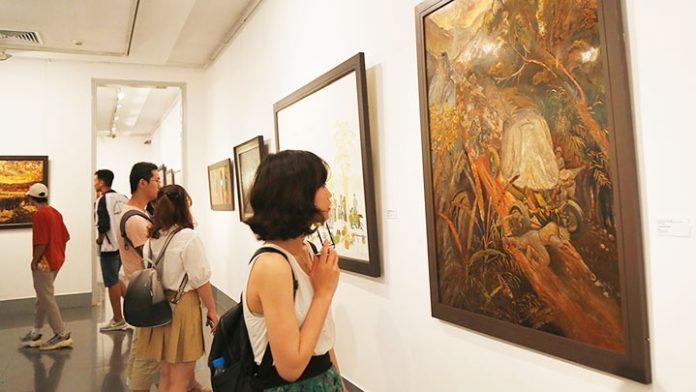Director of Vietnam Fine Arts Museum – Dr. Nguyen Anh Minh
Q: Could you please review the important milestones in the development of the museum?
A: On June 24, 1966, the Vietnam Fine Arts Museum officially opened to visitors. This was an important milestone in the development history of Vietnam’s cultural and artistic heritage industry. During the past 55 years, the museum has collected and preserved nearly 20,000 documents, artifacts and works of art, reflecting the development of Vietnam’s fine art history.
Many works are the pride and joy of the artistic life of generations of painters and sculptors such as a collection of works by authors trained at the Indochina College of Fine Arts (the predecessor of the Vietnam University of Fine Arts); an author who received the Ho Chi Minh awards and the State awards for Literature and the Arts; collections of lacquer, oil and silk paintings; and the works on President Ho Chi Minh. Among these are nine national treasures, including three works of ancient art and six works of modern art.
Especially in the context of the country’s difficulties, its art heritage has not been paid due attention, the forebears have brought many particularly valuable works to the "sacred temple" of Vietnamese fine art. In order for the museum’s collection to have top-notch works, they have visited not only major urban centers such as Hanoi and Ho Chi Minh City but also many other localities.
Q: What are the difficulties the museum has had to face with such a large number of documents, artifacts and works?
A: Funding for the collection of works is quite limited, so many precious and historical works have not been collected yet. Storage and preservation is also a concern because of the harsh climate, high humidity, limited area and equipment, while a large number of paintings and statues require strict preservation conditions. In addition, the old exhibition space and small area do not meet requirements for large art events, especially the contemporary art display segment.
Q: How has the museum made "transitions" to integrate in the growing digital age?
A: Digital transformation is a big challenge. We have launched iMuseum VFA, a multimedia presentation app (a combination of sound, image and articles) across eight languages (Vietnamese, English, French, Chinese, Japanese, Korean, Italian and Spanish) to serve visitors in both online and direct form.
The app uses QR code scanning technology and the iBeacon locator. When scanning the QR code attached to the work, or choosing the works on the system, visitors are able to see images and information about the work in the form of articles.
The museum is also implementing the project "Building an e-library", digitally managing documents and artifacts, step-by-step digitising documents and artifacts to launch a 3D digital museum in the near future, helping visitors experience the museum’s exhibition space, especially as all activities are restricted due to the Covid-19 epidemic.
Q: In order for the museum to further promote its role, what is the orientation of the museum in the coming time?
A: Every year, the museum welcomes more than 60,000 visitors and thousands of students – In 2011, “a creative space for children” was established and operated frequently. In addition to the regular display system, the Museum also organises thematic exhibitions and traveling exhibitions.
The museum always follows the historical events of the country, displaying documents, images and works related to important events such as commemorating President Ho Chi Minh; elections; events marking the anniversary of southern liberation and national reunification; and National Days.
Many exhibitions of domestic and foreign organisations and individuals are presented at the museum, contributing to creating great excitement in artistic activities during the current period.
We will continue to promote digital transformation in the museum’s professional activities, such as expanding the exhibition area; renovating, upgrading and adjusting display content; developing specific tourism products, intensive research programmes for the public and future guides.
In the next few years, a Centre for Contemporary Art will be formed. It will display and organise activities to honour new and excellent visual arts works from domestic and foreign authors. Along with that, the museum also will connect with international art museums, to introduce the Vietnamese fine arts and vice versa. Meanwhile, the museum also plans to promote scientific research; train museum staff to become experts in the fields of remodeling, preserving and researching cultural and art, and museology.
The Vietnam Fine Arts Museum will strive to become an attractive destination that helps the public have a multi-dimensional view of history, culture and art. Meanwhile the museum will also strive to be a reliable address for art researchers and students to explore and study; empowering and motivating artists to create creativity, nurture national pride and self-esteem. Besides, it is also expected to be an attractive place for tourists, contributing to bringing economic benefit to the country.
Thank you so much!





